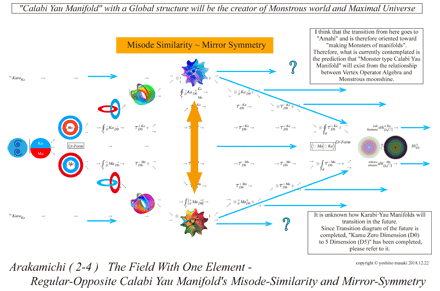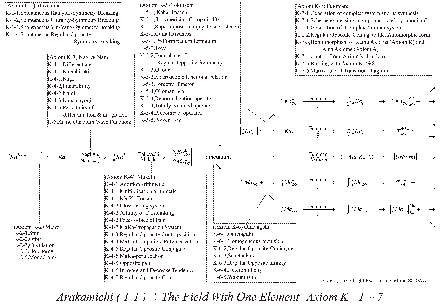Kamu Number Theory
| Contents |
|
Preface
|
| Summery |
|
1.Kamu Axiom system
|
|
2.Kamu Dimension system
|
|
3.Space Time compatible Quantum
|
|
4.Topological model of Ama Universe
|
| Kamu Number Theory |
| ver.2019.10 |
| Masaki Yoshino |
| Masaki Yoshino |
| site opned 2019.2.20 |
| studying Similarity schem theory from 1975 |
| copyright (c) 2019 all rights rezerved |
| blog in English and Japanese |
Mawali, Meguri, Uzume
| New pdf 1-1-9.Futomani 1-1-8.Pair Production 1-1-7.Super Duality 1-1-6.Dyad 1-9-1.What is Ka ? 1-9-2.What is Ka & Ma 1-9-3.What is Ma ? |
| Chapter Index |
|
A4 size pdf Plate Index
|
| Preface |
| Summery |
|
|
|
1.Kamu Axiom System
|
|
|
|
1-1.Construction of Axioms
1-1-1.Axiom K and Axiom A 1-1-2.Field with one Element 1-1-3.Kamu Postulate |
|
1-2.Axiom from K1 to K8
1-2-1-1.K1,MaKaTama Symmetry 1-2-1-2.K1,spontaneous symmetry breaking 1-2-1-3.K1,UrForm and Prototype 1-2-2.K2,Mawari & Rotation 1-2-3.K3,differentiation and integration 1-2-4.K4,Kamu addition and multiplication 1-2-5.K5, Tokotachi Super Duality 1-2-6.K6, Pair Production 1-2-7.K7, Futomani 1-2-8.K8,Yata Phenomenon generation Field 1-2-9-1.What is Ka ? 1-2-9-2.What is Ma ? |
| 1-3.Axiom from A1 to A8 1-3-1.A1,Dynamic Saturation Stability 1-3-2.A2,Ama differentiation and integration 1-3-3.A3,Potential automorphic 4 Phases 1-3-4.A4,Tabane & Formal Power Series 1-3-5.A5,Imatachi & logic of Life. 1-3-6.A6, Compatibility and Duality 1-3-7.A7,Oho & Kamu forgetful Functor 1-3-8.A8,Kamuutsusi & Amautsushi |
| 1-4.Symboles inTransition Diaguram 1-4-1.First Reconsider the Operation 1-4-2.Compatible and Polymetric Additive operation 1-4-3.To Caputure Differenntial Integral with a wave image 1-4-4.Tranqull operation and Tropical Geometry |
| 1-5.Potential cuspidal automorphic form 1-5-1.Making an illustration of "Magatama Symmetry" of Axiom K-1 becomes Cuspidal automorphic form 1-5-2. Cuspidal automorphic form genetically dominating "Axiom A" |
| 1-6. Kamu imaginary Diamond and mirror symmetry 1-6-1. |
| 1-7. Axiom K-5 & 6 and the way to Carabi-Yau manifold 1-7-1. |
| 1-8. Carabi-Yau manifold to E8 Transition process and Axioms K8 |
| 1-9. Axiom A and Lie group U (1), SU (2), SU (3) |
| 1-10. Kamu Rosetta Stone |
| 1-11. Kurokawa multiple trigonometric function model |
| 1-12.Relativity-Capacitive-Quantity and Entropy 1-12-1.Reforming Boltzmann's Entropy definition formula and Information Thermodynamics 1-12-2.Guage Space and Relativity-Capacitive-Quantity |
| 1-13. Newton's map Model of Zeta function |
| Axiom K-2 Mawali, Meguri and Uzume are basically axioms of Rotation or Spin. Elementary charge Quantum generated from <Ka> by Postulate 0-2 is <Mari> which is a Manifold. |
| <Mari> is a concept that designates the same image as a Ball.The first born <Mari> is an <Ka> of an Elementary charge Quantum separated from Ka.It is shown by the Axiom K-1 that <Ka> is generated with "regular and opposite simple" rotation by the spontaneous symmetry breaking. |
| Linearity is generated like a gene for all states by the fact that <Ka> gains linearity by the simplicity of rotation.Because this simple "Rotation" occurs under automorphic form, there is similarity with the Lie group. |
| A simple "rotation = mawari" formed a "group" while "physically dissolving" an Arithmetic operation inside it.The mathematical abstraction of the group is fit comfortably in the Pre-Phenomenon world by "physical property dissolution". |
| In the Kamu number theory, “Latent-Phenomenon-Spin” is regarded as a conjugate of “rotation = Mawari” and “revolution = Meguri”.The reason why this conjugation is important is that the condition necessary to generate "Uzume" is this conjugation.Uzume is Vortex. |
| The concept of spin in complex space defined by quantum mechanics fits the Latent-Phenomenon field well.However, the concept of quantum mechanics can not express the conjugation of "rotation = Mawari" and "revolution = Meguri". |
| With Mawari as rotation and Meguri as revolution, does the concept of conjugation exist in science? Or, with Mawari as holonomy and Meguri as monodromy, can we find a conjugation between them? |
| What seems to be important here is the relationship between monodromy and the Galois group. |
| On the other hand, it is also important for Kamu number theory that the holonomy group is closely related to the Calabi-Yau manifold. As for conjugation of holonomy group and monodromy group, I have to wait for analysis by a mathematical expert. |
| Moreover, I am interested in Twistor.As the name suggests, it only seems to me that it was created from the conjugation between holonomy and monodromy. |
| In recent years, it has been a welcome situation that experts have come up with an easy-to-understand commentary about the Twistor.From my point of view of Kamu Number Theory, I would like to think of Twistor in an approach of similarity. |
 |
| pdf.Arakamichi 1-2-3. |
|
| New pdf 1-1-9.Futomani 1-1-8.Pair Production 1-1-7.Super Duality 1-1-6.Dyad 1-9-1.What is Ka ? 1-9-2.What is Ka & Ma 1-9-3.What is Ma ? |

